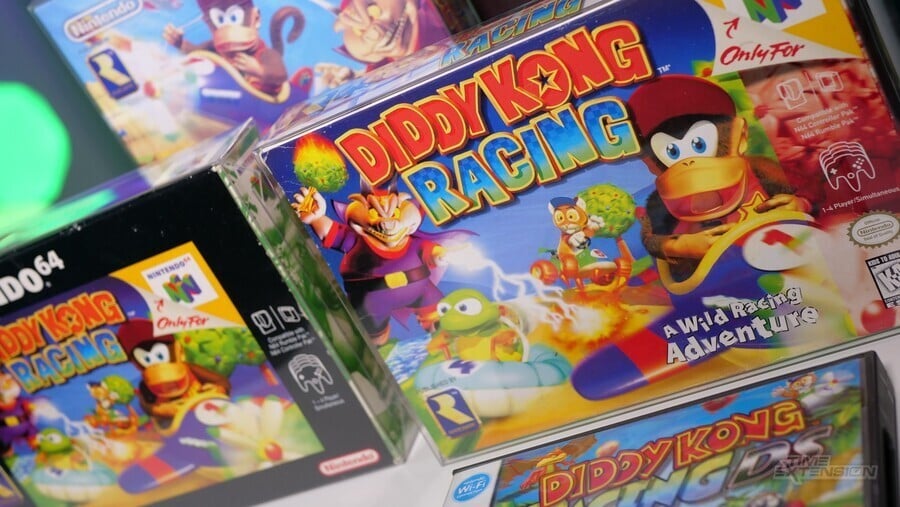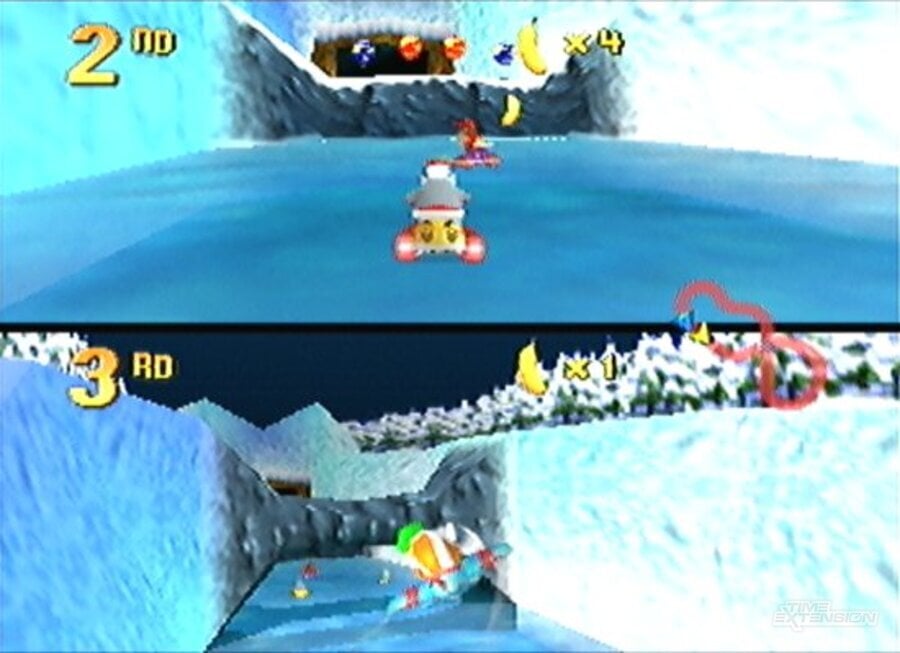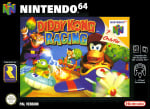
Donkey Kong has had a long and vibrant history on the video game scene. Of course, no examination of Kong’s history would be complete without taking a closer look at Rare’s involvement with the franchise. During the 1990s, the British development studio played a crucial role in not only keeping DK fresh and at the forefront of gamers’ minds, but also in shaping the entire future of the franchise; Donkey Kong Country: Tropical Freeze, for example, is very clearly inspired by the impressive legacy that Rare created.
When developing the original Donkey Kong Country series, the gang at Rare not only worked hard to make great use of the franchise, but it also used it as an opportunity to leave its own mark. One of the most noticeable ways in which it did this was by creating a host of new characters, the most notable of which was Diddy Kong. Despite being a wholly new creation in 1994, Diddy Kong quickly became a popular Nintendo character, taking the lead role in 1995’s Donkey Kong Country 2: Diddy’s Kong Quest before finally getting a game to truly call his own in 1997: Diddy Kong Racing.
This game was not only huge for Diddy Kong’s street cred, but it was also a massive deal for Rare. Fitting neatly into the kart racing genre, Diddy Kong Racing was the first real contender to challenge Nintendo’s dominance over the kart racing genre with Mario Kart 64. And in many ways, Diddy Kong Racing is most certainly the better game; it added a host of new and engaging gameplay features while also offering much tighter controls. When it was released in late 1997, it was a huge hit for a Rare.

We caught up with Lee Musgrave, who worked as a 3D artist on Diddy Kong Racing and a number of other Rare titles before eventually going to become the studio’s Head of Art. He gave us an insight into the game’s fascinating development, as well as what it was like to work at Rare during what many consider to be the studio’s golden era.
For a game that went on to sell an impressive number of copies, not to mention achieve near-universal critical acclaim, Diddy Kong Racing’s origins were remarkably humble. “Right back at the beginning it was just me and Chris Stamper [one of Rare’s co-owners]”, Musgrave tells us. “We’d just finished Killer Instinct II, and while some of the team went off to work on Killer Instinct Gold for the N64, we tried to start making a racing game”.
"Just before Diddy Kong Racing, there was a month's worth of work on a strategy game that I did with Chris Stamper, but that was in the style of Command & Conquer and not related"
Moreover, Diddy Kong Racing’s raison d'etre is slightly less grandiose than you may have previously thought. “We simply didn't have something of the sort in the Rare line-up”, admits Musgrave. This in itself is certainly a testament to Rare’s once impressive versatility and willingness to try new things in the field of game design, which contrasts starkly with today’s industry, in which development studios tend to stick quite closely to certain franchises and genres.
But before we get ahead of ourselves, it’s worth noting that Diddy Kong Racing didn't start off life in the form that we know today. Instead, the initial prototype – which consisted of a small car that drove around a flat plain – evolved into Pro-Am 64, although this wasn't a direct follow-up to the earlier NES and Game Boy titles. For reasons unknown, a rumour persists online today that the game’s very first concept was in fact a real-time strategy game with a caveman/time-travel theme; however, Musgrave confirms that this was never the case. “Just before Diddy Kong Racing, there was a month's worth of work on a strategy game that I did with Chris Stamper, but that was in the style of Command & Conquer and not related. I rendered a few catapults, but other than that it didn't go anywhere and died after a month. We had a go at it, but in the end, it looked like the racing game had more legs”.
But when — and more importantly, how — did Pro-Am 64 actually become Diddy Kong Racing? Musgrave fills us in. “Pro-Am 64 had gotten to a stage where it was being called exactly that; the title screen was done, and it had all new IP invented characters. We got to July 1997, and it turned out that Banjo-Kazooie was going to be the game for Christmas”.
However, N64 owners at the time will recall that Banjo-Kazooie didn't actually release until the next summer. “The team behind Banjo-Kazooie had loads of stuff in the game, but they thought they could really push it towards being a Super Mario 64 killer”, Musgrave explains, “So they wanted to do more on it, which meant that they were going to miss the Christmas slot.” It was a wise move; Banjo-Kazooie was another huge success for Rare, both critically and commercially.
"Nintendo enjoyed the fact that we chose Diddy Kong over Donkey Kong; I think that it was us trying to build on the fact that Diddy was ours, and DK was theirs"
Not only that, but suddenly Pro-Am 64 became the only viable choice for Rare’s Christmas ‘97 game, although there were doubts as to whether the IP was strong enough to capture the attention of consumers. “I don’t know how the politics of it worked, but the decision was made that rebranding the game to Diddy Kong Racing would work better, especially as a Christmas AAA release”. According to Musgrave, the decision to choose Diddy Kong rather than Nintendo’s famous gorilla was their own to make. “Nintendo enjoyed the fact that we chose Diddy Kong over Donkey Kong; I think that it was us trying to build on the fact that Diddy was ours, and DK was theirs”.
With a big IP attached to the project, it was now a case of adapting the game’s visuals to represent this. Musgrave and his colleagues rushed like madmen to change the assets. “Thankfully, the tracks were mostly done, and the pick-ups were arbitrary, made-up things. It was just kind of a rush job to change the packaging of it”.
The team’s speedy work – combined with a dearth of notable N64 releases in the latter half of 1997 – meant that Diddy Kong Racing acquired nearly all of Nintendo’s attention when it came to advertising the title, a luxury which Musgrave says the game likely wouldn't have received if it hadn't been given the coveted Christmas slot. A mass media campaign — involving plenty of TV advertising — meant that the game went on to be a huge success for Rare, selling roughly 4.5 million copies — a staggering number for the time.

Despite releasing shortly after Mario Kart 64, Diddy Kong Racing’s development wasn't influenced by the latter to any real degree. “I suppose the only thing — the struggle — was trying to make it run as fast as Mario Kart 64”, states Musgrave. The speed in Nintendo’s 64-bit kart racer was partly achieved through the use of sprites for the characters, whereas Diddy Kong Racing featured almost fully-3D models. “The wheels in Diddy Kong Racing are in fact sprites”, Musgrave admits, “Rob Harrison, one of our software engineers, created this tech which worked out where the camera would be looking in relation to sprite. It resulted in this really nice effect: 3D cars with sprite wheels that looked solid and real”.
"I suppose the only thing — the struggle — was trying to make it run as fast as Mario Kart 64"
Fans of both games could argue until the end of time about which is better, but it’s fair to say that Diddy Kong Racing not only did a lot of things better than Mario Kart 64, but it also added a wealth of new and exciting features. In particular, Diddy Kong Racing offered a comprehensive adventure mode, complete with boss battles and a light, yet engaging story. Moreover, it added far more depth to the mechanics when it came to control — not to mention that players could also race their way around the tracks in planes and hovercrafts. According to Musgrave, this wasn't a massive or overly ambitious undertaking, but rather the team was looking to provide players with a different experience so that direct comparisons couldn't be drawn. “We had the opportunity to do it, and it didn't feel like a lot of work to add that stuff in”, he asserts, “It was more design and implementation work, as well as having to get the overworld drawn, but it wasn't a huge task”.
The technical wizardry that the team was able to achieve with Diddy Kong Racing, as well as other projects, was borne out of a great work environment. As has been widely reported in the past, Rare’s owners, the Stamper brothers, cultivated a strong sense of competition between teams, which resulted in new games that consistently raised the bar. Nevertheless, it would be wrong to attribute Rare’s technical success solely to the culture it employed; the period in time when Diddy Kong Racing was being developed had just as much to do with it. Musgrave provides some perspective: “At the time, everyone was still learning. Today, look at how many game engines there are, everyone knows how geometry and lighting work; at the time, no one even knew why what they created had to be triangles”.
It was a different time, and one which looks infinitely more exciting in retrospect. The tools available to the team were extremely clunky by today’s standards, and there wasn't much in the way of guidance or resources. “People were learning as they were going, and getting the best out of the N64 was kind of a succession of cunning tricks with which you had to kind of try and out-trick the guy next door”, states Musgrave. The culture, combined with the desire to make your project truly stand out, is what drove the staff to go the extra mile with their projects.

Not only that, but Rare’s bonus scheme was set up so that success was lucratively rewarded. Many of Rare’s N64 titles passed the 'million copies sold' mark by quite a margin; GoldenEye 007, for example, reached around 8 million copies sold, which it achieved within what was then a much smaller, more specialist market.
What makes this seem even more incredible is the fact that games such as Diddy Kong Racing were developed by very small-sized teams within Rare. In this particular instance, a team of around 14 people worked full-time on the project, which Musgrave believes is the absolute sweet spot in terms of working effectively, knowing what everyone else within the team is doing and having fun. Drawing a comparison with today, the former Rare man believes that some of the problems with how things are now is that there is a lack of creative ideas because the money and the teams are simply too big.
"The Stamper brothers were very good at giving you the freedom to do stuff you wanted to do, so everyone on the team felt like it [Diddy Kong Racing] was theirs"
We only need to look back to the era of the N64 to know what sort of impact Rare had on the games industry as a result of its constant drive for perfection. In the seven years that the N64 was on the market, the UK studio developed 11 titles, the majority of which were received warmly by gamers. It is often considered a golden era for the developers, to the extent where it could be argued that it saved the N64 from complete failure.
Musgrave looks back on his time Rare with much fondness. “The culture of the place was whatever you were working on absolutely felt like yours. The Stamper brothers were very good at giving you the freedom to do stuff you wanted to do, so everyone on the team felt like it [Diddy Kong Racing] was theirs”. As a result of this, overtime seemingly wasn't much of an issue for staff, who would happily put in a considerable number of extra hours during the evenings and weekends.
When asked if there was anything that he would change if he could do it all again, it’s apparent that Musgrave still holds himself to the same high standards that he did during his time at Rare. “I was part of the team that developed Mickey’s Speedway USA, which we got to run at a constant 30 frames per second, whereas Diddy Kong Racing doesn't. If I could do it all again, I know I could get it to run at that”.
Diddy Kong Racing may have since disappeared from the mainstream gaming scene – having only reappeared again as an enhanced remake for DS in 2007 – but its legacy still lives on in the memories of many gamers. When you take into account the constant changes the game underwent during its development, the relatively small team that made it and what they managed to achieve as a result, you soon realise that Diddy Kong Racing really is one of those Rare gems that’s truly worthy of all its praise.


